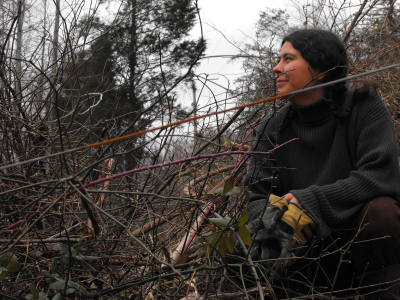
Edges
 Painters
make conscious choices about their pictures' edges because the edges
play a large role in the painting's impact. Ecologists know that
edges promote a diversity of species, more than can be found in either
habitat which the edge joins.
Painters
make conscious choices about their pictures' edges because the edges
play a large role in the painting's impact. Ecologists know that
edges promote a diversity of species, more than can be found in either
habitat which the edge joins.
I've been pondering
edges as I whack back encroaching Japanese honeysuckle, sassafras saplings, and
brambles along the boundary of our garden. I've noticed that my
vegetables are sensitive to even the slightest bit of shade, and that
the boundary beds closest to the thicket produce about half as many
vegetables as do plants in more interior beds. These brushy edges
also delight the deer, who feel safer encroaching
if they can retreat back out of sight in just a few bounds.
Over the last few years,
we've been beating back the edges, first clipping the woody plants,
then running the chicken
tractors across
them, and finally beginning to mow them into a semblance of a
lawn. I don't believe in lawns for prettiness sake, but I do find
them very useful as a way to keep the forest edges from encroaching on
our garden, and the mixed herb pasture keeps our chickens happy.
Want more in-depth information? Browse through our books.
Or explore more posts by date or by subject.
About us: Anna Hess and Mark Hamilton spent over a decade living self-sufficiently in the mountains of Virginia before moving north to start over from scratch in the foothills of Ohio. They've experimented with permaculture, no-till gardening, trailersteading, home-based microbusinesses and much more, writing about their adventures in both blogs and books.
Want to be notified when new comments are posted on this page? Click on the RSS button after you add a comment to subscribe to the comment feed, or simply check the box beside "email replies to me" while writing your comment.
